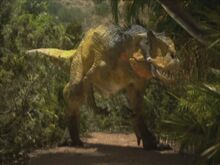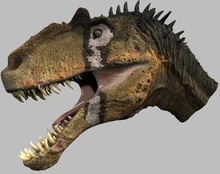| File:Allosaurus dr.jpg | |
| Creature information | |
| Scientific name : | Allosaurus |
| Time period : | Late Jurassic 155-148 |
| Primary diet : | Carnivore |
| In the series | |
| Fatalities caused : | One Ornitholestes |
| Appearances : | The Watering Hole |
Allosaurus (al-OH-sore-US) (March, 1877) meaning, "different, other-lizard", is the main character in The Watering Hole. The Allosaurus is a speices of Allosauroid. The lion of the Jurassic period
Physical Description
Allosaurus was one of the largest Jurassic predators known, growing in average up to 40 feet (12.1 meters). It had a large skull with eye ridges, and claws designed for gripping. It ate many different dinosaurs, such as the Dryosaurus, the stegosaurid Stegosaurus, and even young sauropods like Diplodocus and Apatosaurus.
Due to its large size and 'new-age' design, the previous apex Jurassic predator Ceratosaurus was very hard competition since it was around the same size, but Allosaurus itself had to deal with harder competition from a large megalosaurid named Torvosaurus as well as the also bigger Saurophaganax.
One particularly well-preserved specimen, nicknamed "Big Al", was found not too long ago in Wyoming. While Allosaurus was a hunter, it was also a scavenger. It would find dead animals or animals dying to feast on. "Big Al" had many different injuries from throughout its short, seven year life, yet surviving all but the last one, an infected toe wound. This would have left the animal unable to hunt, and it would have starved and/or died of thirst.
Skull
Allosaurus' skull was double hinged. This allowed it to open its mouth extremely wide, allowing it to have a huge bite radius. One hinge was near the front of the jaw like a snake's, and the other was near the back of the jawbone. However, recent studies seem to show that Allosaurus had a relatively low bite force, much less than the value of sharks and crocodiles and even inferior to that of most big cats, despite being much bigger.
It seems that Allosaurus attacked like an axe, using its double-hinged jaw to open really wide and dropping the top part of its skull into its prey with a large amount of pressure while holding it steady with its strong arms.
A constant repetition of this method would have led to a massive amount of blood loss and shock. It was a very efficient way of killing, and it's probably why Allosaurus was so successful as a hunter.
Paleobiology
Feeding
Paleontologists accept Allosaurus as an active predator of large animals. There is dramatic evidence for allosaur attacks on Stegosaurus, including an Allosaurus tail vertebra with a partially healed puncture wound that fits a Stegosaurus tail spike, and a Stegosaurus neck plate with a U-shaped wound that correlates well with an Allosaurus snout. Sauropods seem to be likely candidates as both live prey and as objects of scavenging, based on the presence of scrapings on sauropod bones fitting allosaur teeth well and the presence of shed allosaur teeth with sauropod bones. However, as Gregory Paul noted in 1988, Allosaurus was probably not a predator of fully grown sauropods, unless it hunted in packs, as it had a modestly sized skull and relatively small teeth, and was greatly outweighed by contemporaneous sauropods. Another possibility is that it preferred to hunt juveniles instead of fully grown adults. Research in the 1990s and first decade of the 21st century may have found other solutions to this question. Robert T. Bakker, comparing Allosaurus to Cenozoic sabre-toothed carnivorous mammals, found similar adaptations, such as a reduction of jaw muscles and increase in neck muscles, and the ability to open the jaws extremely wide. AlthoughAllosaurus did not have sabre teeth, Bakker suggested another mode of attack that would have used such neck and jaw adaptations: the short teeth in effect became small serrations on a saw-like cutting edge running the length of the upper jaw, which would have been driven into prey. This type of jaw would permit slashing attacks against much larger prey, with the goal of weakening the victim.
Brain and Senses
The brain of Allosaurus, as interpreted from spiral CT scanning of an endocast, was more consistent with crocodilian brains than those of the other living archosaurs, birds. The structure of the vestibular apparatus indicates that the skull was held nearly horizontal, as opposed to strongly tipped up or down. The structure of the inner ear was like that of a crocodilian, and so Allosaurus probably could have heard lower frequencies best, and would have had trouble with subtle sounds. The olfactory bulbs were large and seem to have been well suited for detecting odors, although the area for evaluating smells was relatively small.
Social
It has been speculated since the 1970s that Allosaurus preyed on sauropods and other large dinosaurs by hunting in groups. Such a depiction is common in semitechnical and popular dinosaur literature. Robert T. Bakker has extended social behavior to parental care, and has interpreted shed allosaur teeth and chewed bones of large prey animals as evidence that adult allosaurs brought food to lairs for their young to eat until they were grown, and prevented other carnivores from scavenging on the food. However, there is actually little evidence of gregarious behavior in theropods, and social interactions with members of the same species would have included antagonistic encounters, as shown by injuries to gastralia and bite wounds to skulls (the pathologic lower jaw named Labrosaurus ferox is one such possible example). Such head-biting may have been a way to establish dominance in a pack or to settle territorial disputes.
Although Allosaurus may have hunted in packs, it has been argued that Allosaurus and other theropods had largely aggressive interactions instead of cooperative interactions with other members of their own species. The study in question noted that cooperative hunting of prey much larger than an individual predator, as is commonly inferred for theropod dinosaurs, is rare among vertebrates in general, and modern diapsid carnivores (including lizards, crocodiles, and birds) very rarely cooperate to hunt in such a way. Instead, they are typically territorial and will kill and cannibalize intruders of the same species, and will also do the same to smaller individuals that attempt to eat before they do when aggregated at feeding sites. According to this interpretation, the accumulation of remains of multiple Allosaurus individuals at the same site, e.g. in the Cleveland–Lloyd Quarry, are not due to pack hunting, but to the fact that Allosaurus individuals were drawn together to feed on other disabled or dead allosaurs, and were sometimes killed in the process. This could explain the high proportion of juvenile and subadult allosaurs present, as juveniles and subadults are disproportionally killed at modern group feeding sites of animals like crocodiles and Komodo dragons. The same interpretation applies to Bakker's lair sites.[103] There is some evidence for cannibalism in Allosaurus, including Allosaurus shed teeth found among rib fragments, possible tooth marks on a shoulder blade,[104] and cannibalized allosaur skeletons among the bones at Bakker's lair sites.
In Dinosaur Revolution
It first appears with his mother and his siblings sleeping at night, and a noisy Ornitholestes (probably some other coelurosaur, such as Juravenator) wakes them up. The mother goes back to sleep, but it continues, and she roars at it. She goes back to sleep, but this time the babies wake up from the noise and she comes over to it, decapitating it before going back to her babies and going to sleep, before another Ornitholestes wakes her up...
In the morning, the Broken Jaw siblings are eating the Ornitholestes. Broken Jaw is playing with a Ornitholestes skull, possibly the one from the body. It grabs it and throws it very, very far, making it bounce. The baby follows it as it stops on a tree. Only it isn't a tree, it's the leg of an adult Dinheirosaurus. The baby Allosaurus doesn't leave it and one baby Dinheirosaurus (dubbed Woodstock by fans) whacks it with its whip-like tail, breaking the babies jaw. The mother comes, but she abandons him.
Amazingly, he survives somehow on his own, and his jaw heals. He lives at a watering hole, where a Rhamphorhynchus feasts on morsels of his last meal without the Allosaurus attacking him. It goes to the watering hole, after the arrival of the Dinheirosaurus (on of which was Woodstock), and hides behind a bush.

A mother Allosaurus feeding a dead Ornitholestes to her young.
He then stalks a limping juvenile, when Woodstock herself comes behind him and whacks it's tail, knocking a dry tree down. The Allosaurus opens its mouth, and the tail lands into his mouth, and after a brief tug-of-war battle, he rips off the tail and brings it to eat in his spot and he holds it down while eating it. But a roar makes him worry, but he continues eating...
He wakes up under his tree and goes to get a drink from the watering hole. He comes back to find an Ornitholestes on him after it fell from the tree, and chases after it. However, he loses it and resorted to hunting the juvenile Dinheirosaurus again, but a roar from a Torvosaurus distracts him, and makes him worry about his future.
He wakes up and sees a family of one adult Miragaia and three young. However, the Torvosaurus appears and grabs a baby, shaking and killing it. The Allosaurus is impressed as the Torvosaurus disappears with its kill. He then decides to go to the watering hole for just some quick sips of water.

Head of Broken Jaw.
He goes to the watering hole again, but after he drinks, he sees the Torvosaurus has taken his spot. He goes to it, while its resting, and gives a threat display, and when the Torvosaurus doesn't even flinch, he whacks it with his tail, and the Torvosaurus gives its full attention and attacks him, injuring his pelvis (supposedly his crotch). But the Allosaurus escapes when the Torvosaurus gets distracted by the Ornitholestes attacking the Rhamphorhynchus. It retreats to a safe spot where it licks its wounds.
When the Torvosaurus appears and attacks and causes immense chaos at the watering hole, the Allosaurus appears again, and bites down on the megalosaur's neck, but the Torvosaurus throws him down. Fortunately, before the Torvosaurus could kill him, a Dinheirosaurus (Woodstock that is, and the same one which lost it's tail to the Allosaurus) crushes the Torvosaurus. The Allosaurus watches and then eats it.

The Broken Jaw Allosaurus.
It appears next to the sauropod it attacked months earlier, and drinks the water, no more than a large puddle. After all the creatures in the watering hole leave, he stays behind, not knowing why they are leaving. Eventually, enough time later, the rains arrive. And is one of the coolest looking allosaurus ever And he is a Allosaurus europaeus

The model of Broken Jaw's head.

